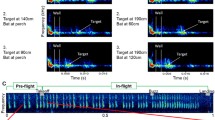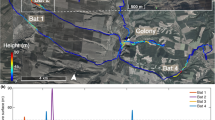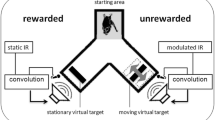Abstract
To understand complex sensory–motor behavior related to object perception by echolocating bats, precise measurements are needed for echoes that bats actually listen to during flight. Recordings of echolocation broadcasts were made from flying bats with a miniature light-weight microphone and radio transmitter (Telemike) set at the position of the bat’s ears and carried during flights to a landing point on a wall. Telemike recordings confirm that flying horseshoe bats (Rhinolophus ferrumequinum nippon) adjust the frequency of their sonar broadcasts to compensate for echo Doppler shifts. Returning constant frequency echoes were maintained at the bat’s reference frequency ±83 Hz during flight, indicating that the bats compensated for frequency changes with an accuracy equivalent to that at rest. The flying bats simultaneously compensate for increases in echo amplitude as target range becomes shorter. Flying bats thus receive echoes with both stabilized frequencies and stabilized amplitudes. Although it is widely understood that Doppler-shift frequency compensation facilitates detection of fluttering insects, approaches to a landing do not involve fluttering objects. Combined frequency and amplitude compensation may instead be for optimization of successive frequency modulated echoes for target range estimation to control approach and landing.






Similar content being viewed by others
Abbreviations
- BF:
-
Best frequency
- CF:
-
Constant frequency
- CM:
-
Cochlear microphonic
- DSC:
-
Doppler-shift compensation
- FM:
-
Frequency modulated
- IPI:
-
Interpulse interval
- RF:
-
Resting frequency
References
Au WWL, Benoit-Bird KJ (2003) Automatic gain control in the echolocation system of dolphins. Nature 423:861–863
Boonman A, Jones G (2002) Intensity control during target approach in echolocating bats; stereotypical sensory–motor behaviour in Daubenton’s bats, Myotis daubentonii. J Exp Biol 205:2865–2874
Edamatsu H, Suga N (1993) Differences in response properties of neurons between two delay-tuned areas in the auditory cortex of the mustached bat. J Neurophysiol 69:1700–1712
Gaioni SJ, Riquimaroux H, Suga N (1990) Biosonar behavior of mustached bats swung on a pendulum prior to cortical ablation. J Neurophysiol 64:1801–1817
Griffin DR (1958) Listening in the dark. Yale University Press, New Haven
Gustafson Y, Schnitzler HU (1979) Echolocation and obstacle avoidance in the hipposiderid bat Assellia tridens. J Comp Physiol A 131:161–167
Hartley DJ, Campbell KA, Suthers RA (1989) The acoustic behavior of the fish-catching bat, Noctilio leporinus, during pre-capture. J Acoust Soc Am 86:8–27
Henson OW Jr, Pollak GD, Kobler JB, Henson MM, Goldman LJ (1982) Cochlear microphonic potentials elicited by biosonar signals in flying bats, Pteronotus p. parnellii. Hear Res 7:127–147
Henson OW Jr, Bishop AL, Keating AW, Kobler JB, Henson MM, Wilson BS, Hansen R (1987) Bisonar imaging of insects by Pteronotus p. parnellii, the mustached bat. Nat Geor Res 3:82–101
Henson OW, Koplas PA, Keating AW, Huffman RF, Henson MM (1990) Cochlear resonance in the mustached bat: behavioral adaptations. Hear Res 50:259–273
Hiryu S, Katsura K, Lin LK, Riquimaroux H, Watanabe Y (2005) Doppler-shift compensation in the Taiwanese leaf-nosed bat (Hipposideros terasensis) recorded with a telemetry microphone system during flight. J Acoust Soc Am 118:3927–3933
Hiryu S, Katsura K, Nagato T, Yamazaki H, Lin LK, Watanabe Y, Riquimaroux H (2006) Intra-individual variation in the vocalized frequency of the Taiwanese leaf-nosed bat, Hipposideros terasensis, influenced by conspecific colony members. J Comp Physiol A 192:807–815
Hiryu S, Hagino T, Riquimaroux H, Watanabe Y (2007) Echo-intensity compensation in echolocating bats (Pipistrellus abramus) during flight measured by a telemetry microphone. J Acoust Soc Am 121:1749–1757
Huffman RF, Henson OW Jr (1993a) Labile cochlear tuning in the mustached bat. I. Concomitant shifts in biosonar emission frequency. J Comp Physiol A 171:725–734
Huffman RF, Henson OW Jr (1993b) Labile cochlear tuning in the mustached bat. II. Concomitant shifts in neural tuning. J Comp Physiol A 171:735–748
Jen PH, Kamada T (1982) Analysis of orientation signals emitted by the CF–FM bat, Pteronotus p. parnellii and the FM bat, Eptesicus fuscus during avoidance of moving and stationary obstacles. J Comp Physiol A 148:389–398
Kick SA, Simmons JA (1984) Automatic gain control in the bat’s sonar receiver and the neuroethology of echolocation. J Neurosci 4:2725–2737
Kobler JB, Wilson BS, Henson OW Jr, Bishop AL (1985) Echo intensity compensation by echolocating bats. Hear Res 20:99–108
Lancaster WC, Keating AW, Henson OW Jr (1992) Ultrasonic vocalizations of flying bats monitored by radiotelemetry. J Exp Biol 173:43–58
Li S, Wang D, Wang K, Akamatsu T (2006) Sonar gain control in echolocating finless porpoises (Neophocaena phocaenoides) in an open water. J Acoust Soc Am 120(4):1803–1806
Metzner W (1993) An audio-vocal interface in echolocating horseshoe bats. J Neurosci 13:1899–1915
Metzner W, Zhang S, Smotherman M (2002) Doppler-shift compensation behavior in horseshoe bats revisited: auditory feedback controls both a decrease and an increase in call frequency. J Exp Biol 205:1607–1616
Moss CF, Surlykke A (2001) Auditory scene analysis by echolocation in bats. J Acoust Soc Am 110:2207–2226
Neumann I, Schuller G (1991) Spectral and temporal gating mechanisms enhance the clutter rejection in the echolocating bat, Rhinolophus rouxi. J Comp Physiol A 169:109–116
Neuweiler G (1970) Neurophysilogische Untersuchungen zum Echoortungssystem der groben Hufeisennase Rhinolophus ferrum equinum Schreber, 1774. Z Vergl Physiol 67:273–306
Neuweiler G (2000) The biology of bats. Oxford University Press, New York
Ostwald J (1984) Tonotopical organization and pure tone response characteristics of single units in the auditory cortex of the greater horseshoe bat. J Comp Physiol A 155:821–834
Riquimaroux H, Watanabe Y (2000) Characteristics of bat sonar sounds recorded by a telemetry system and a fixed ground microphone. Seventh Western Pacific Regional Acoustics Conference (WESTPRACVII):233–238
Riquimaroux H, Gaioni SJ, Suga N (1991) Cortical computational maps control auditory perception. Science 251:565–568
Schnitzler HU (1968) Die Ultraschallortungslaute der Hufeisen-Fledermäuse (Chiroptera-Rhinolophidae) in verschiedenen Orientierungssituationen [The ultrasonic sounds of horseshoe bats (Chiroptera-Rhinolophidae) in different orientation situations]. Z Vergl Physiol 57:376–408
Schnitzler HU, Henson OW Jr (1980) Performance of airborne animal sonar system, I. Microchiroptera. In: Busnel R-G, James FF (eds) Animal sonar systems. Plenum Press, New York, pp 109–181
Schuller G, Beuter K, Schnitzler HU (1974) Response to frequency shifted artificial echoes in the bat Rhinolophus ferrumequinum. J Comp Physiol A 89:275–286
Simmons JA (1974) Response of the Doppler echolocation system in the bat, Rhinolophus ferrumequinum. J Acoust Soc Am 56:672–682
Smotherman M, Metzner W (2003) Fine control of call frequency by horseshoe bats. J Comp Physiol A 189:435–446
Suga N (1984) The extent to which biosonar information is represented in the bat auditory cortex. In: Edelman GM, Gall WE, Cowan WM (eds) Dynamic aspects of neocortical function. Wiley, New York, pp 315–373
Suga N, Jen PH (1976) Disproportionate tonotopic representation for processing CF–FM sonar signals in the mustache bat auditory cortex. Science 194:542–544
Suga N, Niwa H, Taniguchi I, Margoliash D (1987) The personalized auditory cortex of the mustached bat: adaptation for echolocation. J Neurophysiol 58:643–654
Taniguchi I (1985) Echolocation sounds and hearing of the greater Japanese horseshoe bat (Rhinolophus ferrumequinum nippon). J Comp Physiol A 156:185–188
Thomas JA, Moss CF, Vater M (2003) Echolocation in bats and dolphins. University of Chicago Press, Chicago
Tian B, Schnitzler HU (1997) Echolocation signals of the greater horseshoe bat (Rhinolophus ferrumequinum) in transfer flight and during landing. J Acoust Soc Am 101:2347–2364
Vogler B, Neuweiler G (1983) Echolocation in the noctule (Nyctalus noctula) and horseshoe bat (Rhinolophus ferrumequinum). J Comp Physiol A 152:421–432
Acknowledgments
We thank Prof. James A. Simmons for careful reading of the manuscript and valuable comments. We also thank T. Hagino, M. Fukuda, E. Fujioka, M. Omura and Y. Osawa for analysis and technical support during this experiment; N. Urano for assistance in capturing bats in the field. The experiments complied with the Principles of Animal Care, publication no. 86–23, revised in 1985, of the National Institutes of Health, and the procedures were approved by the animal care committee of Doshisha University. This work was partly supported by a grant to the Research Center for Advanced Science and Technology (RCAST) at Doshisha University from the Ministry of Education, Culture, Sports, Science, and Technology (MEXT) of Japan: Special Research Grants for the Development of Characteristic Education from the Promotion and Mutual Aid Corporation for Private Schools of Japan and the Innovative Cluster Creation Project.
Author information
Authors and Affiliations
Corresponding author
Rights and permissions
About this article
Cite this article
Hiryu, S., Shiori, Y., Hosokawa, T. et al. On-board telemetry of emitted sounds from free-flying bats: compensation for velocity and distance stabilizes echo frequency and amplitude. J Comp Physiol A 194, 841–851 (2008). https://doi.org/10.1007/s00359-008-0355-x
Received:
Revised:
Accepted:
Published:
Issue Date:
DOI: https://doi.org/10.1007/s00359-008-0355-x




